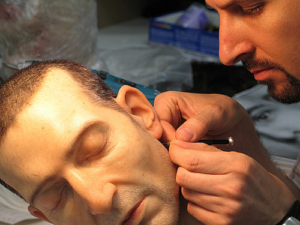My husband’s uncle lives in Melbourne, Australia and recently sent me a link to the works of a Melbourne artist by the name of Sam Jinks. I was immediately captivated by the sculptures that loaded to my screen. Sam Jinks, a hyperrealist artist, captures his subjects as they might appear in a photograph or viewed by the human eye. Often times the sculpture that is created captures a social, cultural, or political subtlety that requires the viewer to examine the subject closely and carefully. His art is in paying close attention to the understated details of his subjects.
 As educators, we are given the task of paying close attention to our subjects so that we may pick up on the slight and delicate components they bring with them as students. The February 2010 edition of Educational Leadership is titled Meeting Students
As educators, we are given the task of paying close attention to our subjects so that we may pick up on the slight and delicate components they bring with them as students. The February 2010 edition of Educational Leadership is titled Meeting Students Where They Are. Inside are articles such as Start Where Your Students Are, Stepping into Students’ Worlds, and The Teacher Who Made Me Speak. The articles provide a rich compilation of anecdotal and research-based text on the importance of closely examining our students. Within this issue, Carol Ann Tomlinson’s reflects in her article One Kid at a Time, “I have learned the most about teaching by studying the students I teach.”
Where They Are. Inside are articles such as Start Where Your Students Are, Stepping into Students’ Worlds, and The Teacher Who Made Me Speak. The articles provide a rich compilation of anecdotal and research-based text on the importance of closely examining our students. Within this issue, Carol Ann Tomlinson’s reflects in her article One Kid at a Time, “I have learned the most about teaching by studying the students I teach.”
In this same issue, Caltha Crowe, a Responsive Classroom practitioner, offers strategies that assist us in examining our students closely: find out about students before school starts; pay attention to triggers; understand children’s developmental stages; observe individual learning styles; notice relationship-building skills; learn some details of students’ daily lives; and find what’s likeable in each student. As she states, “The energy we put into getting to know our students will ultimately make the year go more smoothly.” As your school year comes to an end and you prepare for your fall students, consider what strategies you might use to get to know your next set of students.

